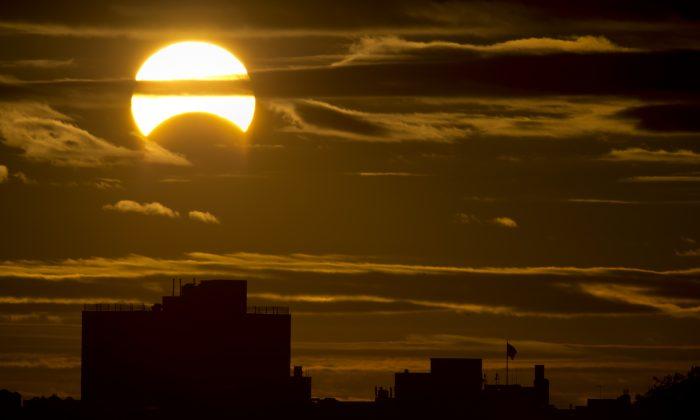A partial solar eclipse is set for Thursday, October 23.
The celestial event is of particular interest because it will be widely visible in the United States and Canada.
The eclipse will be visible in many big cities. It will start in the afternoon.
Start times (pdf) in key cities include 5:49 p.m. EDT in New York City, 5:52 p.m. in Washington, D.C.,4:48 p.m. CDT in Dallas, and 3:18 p.m. MDT in Denver.
The eclipse will last for about an hour.
“It’s a partial solar eclipse,” explained longtime NASA eclipse expert Fred Espenak. In other words, the New Moon is going to ’take a bite' out of the sun.
“A total eclipse is when the Moon passes directly in front of the sun, completely hiding the solar disk and allowing the sun’s ghostly corona to spring into view. A partial eclipse is when the Moon passes in front of the sun, off-center, with a fraction of the bright disk remaining uncovered,” NASA said.
Everyone in North America will be able to see the eclipse, weather permitting.
“Observers in the Central Time zone have the best view because the eclipse is in its maximum phase at sunset,” says Espenak. “They will see a fiery crescent sinking below the horizon, dimmed to human visibility by low-hanging clouds and mist.”

Some people in the West may have a tough time.
“Viewing conditions in the West will not be good across northern California, Washington, Oregon, Idaho and western Montana with clouds and showers moving through that region,” AccuWeather Meteorologist Brian Edwards said.
“There will be good viewing conditions across the Southwest and the Four Corners region.”
Astronomer Bob Berman noted that the partial solar eclipse teaches us the science of celestial motion and how the moon moves through space.

“At maximum, only 81 percent of the sun will be covered,” Berman said. “By and large, no matter where you are, it’s going to be something when the sun is low in the sky in the West during late afternoon.”
Sunglasses are not suitable for viewing.
Ways to view the eclipse include projection, by making a pinhole camera.

“Place a pinhole or small opening in a card, and hold it between the sun and a screen – giant sheet of white paper works – a few feet away. An image of the sun will be seen on the screen,” NASA said.
“Projected images of the sun’s crescent during an eclipse may even be seen on the ground in the small openings created by interlacing fingers, or in the dappled sunlight beneath a leafy tree. You can also use binoculars to project a magnified image of the sun on a white card.”
Filters are also an option, along with telescopes with solar filters.
“The sun can be viewed directly only when using filters specifically designed for this purpose. Such filters usually have a thin layer of aluminum, chromium or silver deposited on their surfaces. One of the most widely available filters for safe eclipse viewing is a #14 (or darker) welder’s glass. A welding glass that permits you to see the landscape is not safe. Aluminized mylar manufactured specifically for solar observation can also be used. Mylar can easily be cut with scissors and adapted to any kind of box or viewing device.”






Friends Read Free